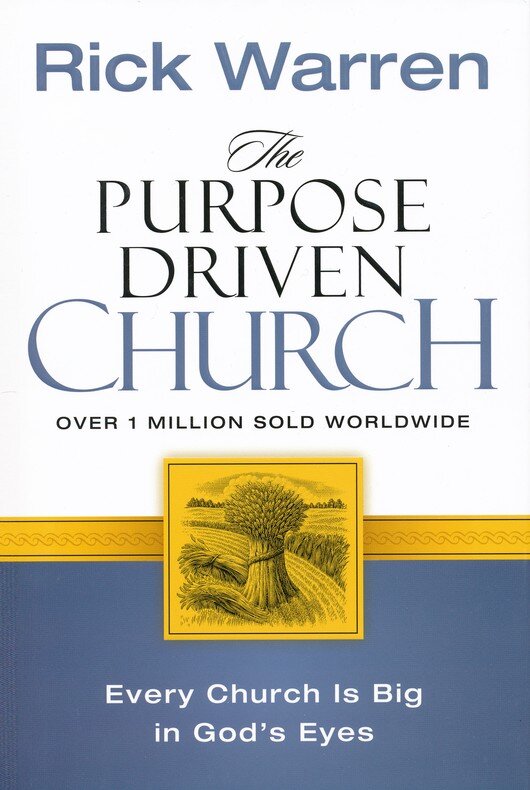Rick Warren, Purpose-Driven Church: Growth Without Compromising Your Message and Mission. Zondervan, 1995.
Referenced in: Strategies for Congregational Renewal: Diagnostic/Prescriptive
LifeandLeadership.com Summary
It is difficult to overstate the impact of this book on churches worldwide. It is perhaps the most widely known and widely used resource on church development. It began as Rick Warren’s five-point strategy for leading the Saddleback Church to such phenomenal success. Launching from the Saddleback story, Warren began conducting seminars to large audiences of ministers who wanted to learn his approach, many that have effectively implemented his techniques. The book followed. Since its original printing in 1995, it has helped innumerable churches and ministers.
The book is divided into five parts.
Part One, Seeing the Big Picture, tells the Saddleback Story, exposes the myths regarding growing churches, and lays out the essentials of his approach. He says,
My definition of church growth has five facets. Every church needs to grow warmer through fellowship, deeper through discipleship, stronger through worship, broader through ministry, and larger through evangelism.
In this way, he distinguishes between church growth and church health, with growth being the natural result of health, if each of these five dimensions is balanced. He also rejects the false dichotomy of quantity vs. quality, arguing it is possible to have both.
Part Two, Becoming a Purpose-Driven Church, suggests churches should have a fundamental, biblical purpose rather than being driven by factors such as events, seekers, etc. He discusses how to define, communicate, organize around, and apply this purpose to all aspects of congregational life.
Part Three, Reaching Out to Your Community, discusses the concept of targeting a population of the surrounding community that a church is best equipped to reach.
Part Four, Bringing in a Crowd, develops the attractional model of church growth, centered around seeker-sensitive worship and preaching.
Part Five, Building Up the Church, presents the Saddleback maturing sequence that intentionally moves people from crowd (unchurched seekers), to attenders (congregation), to mature members (committed), and then to ministers (core). This section includes a thorough description of the popular diamond model of assimilating and involving members through the Life Development Process (101, 201, 301, 401). He also shows how Saddleback uses methods such as membership covenants, the S.H.A.P.E. method of spiritual gifts assessment and ministry placement, etc.
As far as approaches to church renewal, Warren is prescriptive, but not diagnostic. He is prescriptive in that he suggests every healthy church exhibits the five biblical purposes. On the other hand, he acknowledges not all churches should or can use all the methodologies presented. He is more interested in suggesting the over-arching principles, and offers the Saddleback methods as tools he and others have used to activate the principles.
Although Purpose-Driven Church is not a planning model, Warren often recommends to those who are serious about becoming purpose-driven the planning procedure by Stephen Macchia, Becoming a Healthy Church and its companion, Becoming a Healthy Church Planning Workbook. These two developed independent of each other, but the Macchia workbook shows how to correlate the two.
Warren is not without his critics. On the other hand, it is difficult to imagine a church that could not benefit greatly from knowing the Saddleback principles. Warren is certainly representative of the attractional, seeker-sensitive, church growth model, yet few express this philosophy better than him. Many of his principles are found among missional/emerging enthusiasts as well. This is must reading for those interested in contemporary church development.
From the Publisher
This is a five-point strategy for attracting and spiritually maturing the unchurched, from the pastor of Saddleback Church.
Editorial Reviews
What Drives Your Church? “The Purpose-Driven Church has brought focus and direction to more pastors and church leaders than you can count. What a gift! I can’t imagine anyone who’s serious about the church not reading it.” John Ortberg Author of Everybody’s Normal Till You Get to Know Them
“After reading The Purpose-Driven Church in 1995, I ordered twenty copies for my staff and elders. Eight years later, the message and strategy contained in this work are as significant and relevant as ever.” Andy Stanley Senior Pastor, North Point Community Church
“In 1985, I heard Rick present the contents of this book in a seminar format. As he spoke, for the first time I imagined leaving my teaching career in higher education to enter pastoral ministry. My heart was won by Rick’s vision of the Church driven by her God-given purpose—rather than by doctrinal arguments, denominational competition, or institutional survival. That vision has been alive in me ever since, and you can catch it too, through these pages.” Brian McLaren Pastor, Author, Fellow in Emergent (Emergentvillage.com)
“One hundred years from now church leaders will be studying the movement known as ‘purpose driven’ churches. They will find Rick Warren as its architect and The Purpose-Driven Church as his blueprint.” Erwin Raphael McManus Founder of Awaken and Lead Pastor of Mosaic
“Although the actual form of ministry may look different from different types of people, there are extremely critical principles within this book that we all need to know, no matter what generation or philosophical mindset we are involved with.” Dan Kimball Author of The Emerging Church and Pastor of Vintage Faith Church
Discover What Business Leaders Can Learn from the Church “The best book on entrepreneurship, business, and investment…” Rick Karlgaard Forbes Magazine
About the Author
Dr. Rick Warren, founding pastor of Saddleback Church in Lake Forest, California, is the author of the New York Times #1 bests The Purpose Driven Life. With over 10 million copies sold since its release in October, 2002, the book has twice received the ECPA Book of the Year Award in 2003 and 2004.
***For additional information on this resource, including reviews, click the bookstore links. Check the reference at page top or the links below for resource guides on related topics.***
See Resources on Over 100 Areas of Ministry Leadership:


